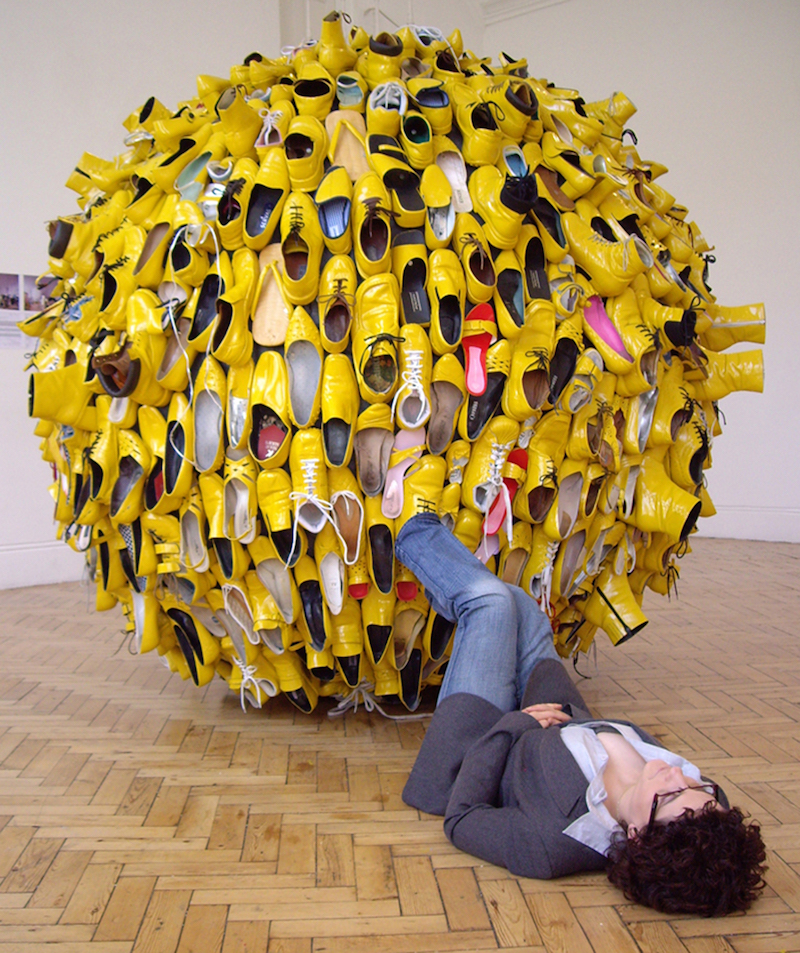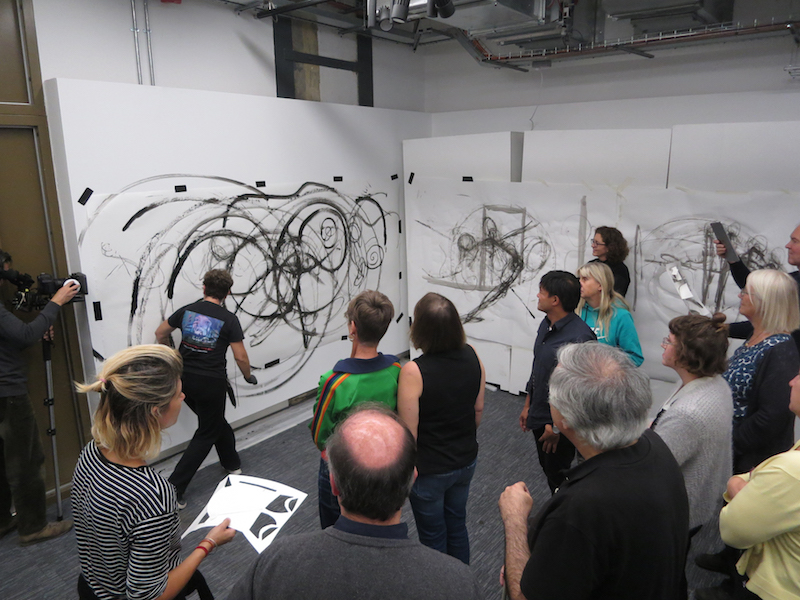by Zoë Ritts // Dec. 18, 2020
The DisOrdinary Architecture Project is a UK-based practice that seeks to develop new processes of spatial design and spatial justice in the built environment. Founded by Jos Boys, a researcher and educator, and Zoe Partington, an artist whose work is informed by her experiences with sight loss, DisOrdinary works with students, Deaf and disabled artists and institutions to challenge the ableist limitations of the built environment, and to incorporate disability into architectural design practices and pedagogies.
In the last decade, DisOrdinary has explored the often ignored experiences that varied bodies have in using, occupying and designing architecture and urban space. Their work, in concert with “creative expert” Deaf and disabled artists, begins with an understanding of difference, rather than conceiving of accessibility as a best-practices afterword.
Architecture plays a powerful role in applying spatial injustices upon the body, individual and collective, and so carries an equivalent potential to radically reconfigure that action. Architecture also shapes our understanding of what a body is, through spatial design and the imposition of Vitruvian, Moduloric and other ableist norms. Citing Spinoza, Léopold Lambert has suggested that perhaps we don’t even know what a body is. How does architecture respond to this prompt? New York conceptual artists of the 1960s, Arakawa and Gins, for example, propose that we are not closed, hermetic forms but rather “architectural bodies,” extending beyond the boundaries of muscle and flesh to contain our immediate spatial environments, too.
Such theoretical work is knowledge that has long been embodied by Deaf and disabled artists and architects, who provide vital understanding about what bodies can be, and how the built environment can better accommodate and engage us all. DisOrdinary and their collaborators advance this kind of accessibility, and in doing so, the overall quality of its design. A space that is accessible to Deaf and disabled bodies becomes a more usable, inclusive and rich space overall.
Zoë Ritts: What are some of the fundamental changes that need to occur in the practice of architecture towards a culture of greater accessibility and spatial equity in the built environment?
Zoe Partington: To ensure change happens, we need to share and understand the complexity of disability discrimination and, when designing, consider “starting from difference” as a way forward. We need to recognise that we have different bodies and move through spaces with a range of needs. We need more disabled people represented in our architecture and design schools, we need to eliminate “internalised ableism” by making our cultures not force disabled people to fit into restricted physical and intellectual mindsets. We need to be honest about what the barriers preventing disabled people from being at the decision-making tables are and how fundamentally this will be changed with a step-by-step equalities action plan. We know disability arts and equality has been more developed in art and culture than in the built environment, so we have set up DisOrdinary to benefit architectural practice, by working with creative disabled artists to engender change. And our experiences have been very positive. Even if disabled architects are not always present, there’s a huge opportunity to work with creative disabled experts. Generally, we need more disabled role models who have experience and skills to share and who want to change mundane access solutions.
ZR: DisOrdinary recently did a workshop here (digitally) in Berlin with fem_arc, which itself grew out of the school of architecture at the Universität der Künste (UdK). Can you speak to the need to integrate questions of ability and accessibility into architectural pedagogies?
ZP: It is really important that it is part and parcel of everyone’s DNA to understand accessibility and the language around disabled people, which is oppressive or ableist in its intentions. I’ve seen some terrible examples where a tutor decides to build in an accessible workshop and defines the solutions by designing for disabled people by simulating being a disabled person. This still excludes disabled people from the conversation and can perpetuate myths, such as the idea that a blind person needs a guide or can’t orientate in a space in a non-visual way. It also separates disabled people, and focuses on a fear of having lost something. Introducing disabled experts into the conversation enables you to start from difference and make it exciting, fun and challenging in a good way. Disabled people don’t sit around feeling sorry for themselves, but we do wonder why something has been designed so badly. If I suggested that you design a new arts centre, and in the process that you make sure disabled people can’t get in, you would be surprised and shocked (I hope). If you design a space and it excludes some people, how did you make that decision? The campaigning statement “nothing about us, without us” still rings very true.
ZR: In his recent book ‘Against Creativity,’ Oli Mould argues that disabled people, who he terms ‘diffabled,’ have “the potential to be radically ‘creative’ because they are attuned to, and to some extent bring into being, entirely new and alternative subjectivities that are beyond the normalized world.” What are some examples of DisOrdinary projects or collaborators’ work that might exemplify expanded ways to experience and make space?
ZP: Disabled people have been saying this for over 100 years. Helen Keller 100 years ago understood this in her work and conversations. If you have to make different decisions every day to just get to the shops, you become a creative thinker and problem solver. Non-disabled people may never have to think about a small task in a different way as they can just, for example, turn on a tap. At DisOrdinary we like to think we are doing things differently for a variety of interconnected reasons: paramount is the enjoyment of the diversity of being in the world and valuing the different ways people occupy space. As an example, I think its worth looking at Deaf Space in America Galludet University.
Many of our workshops are developing this thinking around expanded ways of experiencing, making and designing space. During our programme ‘Architecture Beyond Sight’ (ABS) at the Bartlett School of Architecture, we encouraged blind and partially sighted artists/designers to work alongside practicing architects to think about how you could share design ideas, if you had a blind architecture student on your course. Mandy Redvers Rowe presented their designs by performing the space, and another team presented the space through an audio description, describing the space without visuals to encourage people to listen and observe in a new way.
DisOrdinary works with disabled artists, like Noëmi Lakmaier, as we investigate how designing from and with diverse bodies opens up important questions about who counts as “normal,” what kinds of bodies get taken notice of in design and how to work towards architectural and built environment practices based on social and spatial justice.

Noëmi Lakmaier: ‘Experiment in Happiness’, 2008 // Photo by Hannah Facey, courtesy of Noëmi Lakmaier
ZR: Critiques of architecture’s emphasis on vision as the most valuable of the senses have long existed, and are certainly embodied in non-Western traditions and cultures. Can you speak to the other senses, skills and assets engaged when not designing by sight alone?
ZP: Touch, light, scent and acoustics can create an ambience or welcoming space. If you use a material from a design catalogue without holding the sample, you aren’t emphasising the human quality. Blind architects design from models and then learn how to transfer to “sighted” colleagues or clients. Sighted architects or designers would produce more enhanced visions if non-visual engagement was considered from the start. It’s the same old story of retrofitting: you design a space, a building and add on the access afterwards. What if instead you began with designing from a sensory perspective and it was embedded in the designs from the beginning? How different might the choices you make be? I have found the work of architects and designers in Brazil, particularly Lina Bo Bardi, as good examples of starting from a different place of human connection. It’s not starting from disabled people, but it includes everyone in society.
ZR: Many of your projects involve performance, dance or a dimension of live engagement with space. What does this convey about a need to activate and embody architecture? Or, what might it say about when a design is “finished” or not?
ZP: Drawing designs on paper or via computer-aided design is one important element, but does it create less inclusive spaces by not recognising how different we all are. Enjoying and investigating spaces with our bodies takes it to another level and can encourage designers to think about who uses the space and who doesn’t use the space and why a disabled person may not enter a space. Is the doorway too narrow, are the wayfinding guidance routes confusing? Are there places to rest? Many of these elements can be missed if you haven’t experienced barriers in a space. The barriers can be poor acoustics, the materials might be hard and sound bounces around the space and makes you feel disorientated. If you need to rest or lie down, has a space been designed for this?
ZR: How does the design of space carry particular potential to shift social values around the perception of varied bodies and abilities?
ZP: If you design for difference, then more excluded people will use those spaces and become visible. These good practice models will, by the very nature of all our society being visible, develop discourse between communities and encourage people to think in new ways and understand the potential of difference.
This article is part of our feature topic of ‘Accessibility.’ To read more from this topic, click here.
Additional Info

DisOrdinary Architecture Project: ‘Architecture Beyond Sight,’ Architect Judit Pusztasxeri with blind and partially sighted participants // Courtesy of Zoe Partington




















